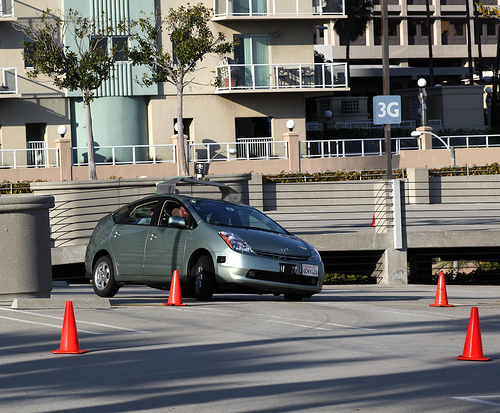Within just five to seven years, reports Mashable, driverless cars will be cheaper than human-driven cars. That prediction is based on Cisco’s “technology trend watchers” analysis. Google, which earlier this year announced advanced integration of super-precise road maps with the company’s robot-driven vehicles, is best known for its driverless vehicles innovations, but Nissan is also poised to make an impact.

Better decisionmaking will drive massive savings on insurance accident costs, which account for a surprisingly big proportion of vehicles’ fixed costs. From Jurvetson.
As DMV.com analyst Jordan Perch explained to Mashable, “Considering that not only Google, but also automakers, such as Nissan, Audi and Toyota, are intensifying their efforts to develop advanced autonomous-driving technology, it’s safe to say that driverless cars could go mainstream in about 10 to 15 years… Google is confident that it will be able to launch a self-driving car by 2025, and Nissan is even more optimistic, saying that it will bring an autonomous car to the market by 2020.”
How would driverless cars incur less cost than human-driven cars? Mashable investigated, speaking with a range of experts. Chunka Mui, managing director of The Devil’s Advocate Group told the site,”It’s a best-case scenario, from a technology perspective, but possible.” Mui noted two important kinds of costs: vehicle operation costs and accident-related costs. Accident-related costs relate to medical and insurance bills, as well as “ethics and decision-making,” all of which total approximately $450 billion yearly, according to Mui.
Vehicle engineering expert, Ravi Pandi, notes insurance companies might offer incentives for driverless car owners. “When autonomous vehicles are proven safe for roads, at scale, insurance companies will pass on significant rewards to those using such a vehicle,” Pandit explained. “Even today, many insurers will pass on savings if the vehicle owners allow access to driving parameters such as speed, location, time and acceleration/deceleration patterns.”
Another cost is even more difficult to consider, but a necessary one: What happens when a driverless car is involved in an unavoidable, “no-win” accident? How should a vehicle be programmed to crash, asks Mashable. “Swerve into children, swerve into adults, or what?”
Within just 11 years, consulting firm IHS forecasts that there may be 230,000 autonomous cars on the road, with that number rocketing to 12 million by 2035. The vehicles may cost about $10,000 more than a traditional car — although that may be a lower estimate, as Google’s driverless technology runs about $250,000 — and they will largely be a popular product for wealthy consumers, at least at first.
Yet, as Mashable explains, the cost savings of buying a driverless vehicle may justify the heftier initial investment. The average American passenger car incurs fixed yearly ownership costs of $8,700 and above. Yet, an autonomous car, “in part due to its ability to communicate with other smart and connected cars on the road, driverless or not, as connected-car tech presumably becomes more commonplace — would help eliminate some 80% of human-caused crashes involving that vehicle.”
Such a drop in crashes would result in a $1,800 savings for vehicle owners, bringing the average annual operating costs to about $6,900. Another part of the analysis means looking at the type of vehicle ownership. Currently, traditional cars are used under five percent of their time. Autonomous car-sharing would reduce costs — if three users split costs, the yearly costs would drop to just $2,300 for a driverless car.
Explains Mashable, in this scenario, users would spend just “25% of what you’d spend to operate a human-driver vehicle. Would 75% savings be a tipping point for the consumer? All other factors aside, at this rate you’d pay back a $10,000 premium on a driverless car in your second year of shared ownership (at an average of $4,600 savings per owner), or in your sixth year if you owned it alone (saving, on average, $1,800 annually).”
Of course, these are just projections. Driverless cars would still face adaptation challenges, including issues related to introducing driver-free cars on roads designed for traditional vehicles. Yet safety benefits and cost savings mean that the tipping point for autonomous vehicles is approaching just as quickly as the related technology is developing.